- Home >
- Short-tailed Albatross >
- Study
Short-tailed Albatross
Studying the Short-tailed Albatross
Update: June 21, 2017
Besides the Operation Decoy, Yamashina Institute for Ornithology is carrying out various investigations and research related to the Short-tailed Albatross in order to recover the population. To protect the species, it is important not only to increase the number of individuals but also to understand their ecology and habitat and to obtain fundamental grounding for effective conservation measures. Some of such research activities are introduced here.
Satellite tracking of flight routes of the Short-tailed Albatross
Understanding the yet-unknown marine habitat
Short-tailed Albatrosses return to Torishima in October, lay eggs and raise their chicks and leave the island again in May. From May to October, they travel in the north Pacific without landing for a stop-over. Understanding where and how they live above the sea during the non-breeding season (when they are away from Torishima) is as important as understanding how they live in Torishima. It is also important to know where they get their food for their chicks during the breeding season (when they lay eggs and raise the chicks in Torishima). For an example, there are many reported incidents of Short-tailed Albatrosses dying by swallowing longline fishing hooks dropped by fishing boats, but where such incident occurred or how it occurred were often unknown making it difficult to formulate an effective measure. By elucidating their marine distribution, it would make it possible to identify their important food resource, and what type of fishing boats might by-catch Short-tailed Albatrosses and enables formulation of effective conservation measures. In the past, habits of the Short-tailed Albatross were extremely difficult to investigate and estimations were made by limited observations from boats and ships. In the recent years however, tracking research is made possible using a satellite, which has opened an avenue for understanding marine distribution of the Short-tailed Albatross.
Transmitters attached on Short-tailed Albatross
Transmitters weighing about 40 to 70 grams is attached on the back of Short-tailed Albatrosses for satellite tracking. Generally when attaching a leg band or other investigation equipment on a bird, the weight of the equipment needs to be less than 3% of the weight of the bird in order to prevent any negative impact on the individual. In case of Short-tailed Albatrosses, a transmitter weighs less than 2% of the weight of the bird, thus it is safe. The impact that it affects on individuals may not be null, but this investigation permits formulating effective conservation measures that can save many Short-tailed Albatrosses. In other words, without this investigation, it may not be possible to remove the causes for many deaths of Short-tailed Albatrosses. We believe that there is enough reason for installing transmitters on a limited number of individuals and conducting this investigation.
The transmitters send signals by a battery and the battery life can be adjusted by setting an appropriate time interval for transmittance. The ones installed in the past have been set to 3 months to 12months, and the transmitters are designed so that they drop off by shedding of feathers after the end of the batter life.
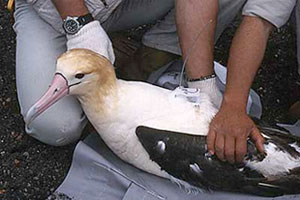
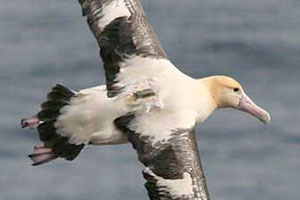
Transmitters attached on Short-tailed Albatrosses
"Argos system" receives and analyzes tracking signals from Short-tailed Albatrosses
"Argos system" developed by France and US in 1978 for conservation and observation of earth environment is used for satellite tracking of Short-tailed Albatrosses. The tracking signals sent from the transmitter attached to the back of Short-tailed Albatrosses are caught by satellite NOAA which goes around the earth, and is sent to the ground receiving station. From there the data is sent to an information processing center for positioning analysis via telephone lines and then is displayed on the computer at the Yamashina Institute for Ornithology in Abiko City, Chiba. It takes 3 to 4 hours for a message sent from an albatross to be received at the institute. This Argos system is also used for tracking of cranes, eagles and shearwaters, investigation of whales and sea turtles, ocean current studies and yacht races.
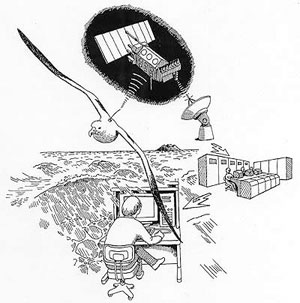
Short-tailed Albatrosses spend their summers in the Aleutians
From the past investigations, it is becoming known that Short-tailed Albatrosses that leave Torishima in May and spend summer in the ocean around the Aleutians Islands.

In the case of the three individuals equipped with transmitters in May 2001, after leaving Torishima in May the birds took two separate routes. One flew northwards slowly along the coast of Honshu, then went over the sea near Nemuro Peninsula and then to the Kuriles, and the other flew northwards over the continental shelf to the east of Honshu. Two individuals arrived in the Aleutians. One of them stayed in the sea around the Aleutian Islands from mid July to mid August, and then moved to the Gulf of Alaska. This indicates that the Aleutians is an important feeding area in the summer for the Short-tailed Albatross. Furthermore, the coastal waters of the Tohoku region of Honshu is also suspected to be an important feeding area.
This satellite tracking was implemented as a commissioned project by the Ministry of the Environment since 1996, and was conducted in cooperation with the U.S. Fish and Wildlife Service since 2001.
Real-time observation of Short-tailed Albatrosses in Torishima
Continuous observation in an uninhabited island becomes possible
The ecological information of the Short-tailed Albatross is vital for their conservation. However, their breeding ground, Torishima, is an uninhabited island and lots of money and time are required for going there. Observation requiring long-term stay cannot be done easily. Conventionally the ecology of the Short-tailed Albatross was assessed by putting together fragmented information each gained by one to two weeks of stay. However, the video image transmission system using satellite cell-phones introduced in 1998 makes it possible to obtain more information through real-time images.
Transmitting images via satellite
This video image transmission system was developed by NTT DOCOMO. The two video cameras are installed on the slope of Hatsunezaki in the west of Torishima where the Operation Decoy is being carried out. It is set so that the reactions of short-tailed albatrosses to the decoys and activities of breeding pairs can be recorded. The image data is sent to Yamashina Institute for Ornithology 600km away via satellite mobile communication service of NTT DOCOMO. Zooming or changing angles of the cameras can be operated remotely from the institute. There is no electricity in Torishima thus the system is operated by solar generation using solar battery panels. The cameras installed in Hatsunezaki are covered by a camouflage painted box in order to minimize the impacts to the birds.
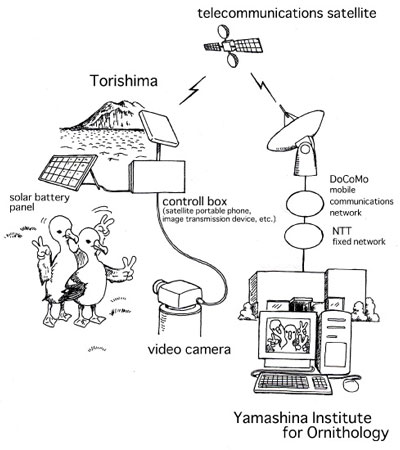
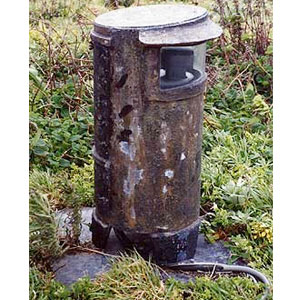
unmanned camera in a box
Revealing the ecology of the Short-tailed Albatross
Some images from the video image transmission system are shown here. These are some samples of saved images.
The images below are still images recorded by the video image transmission system.
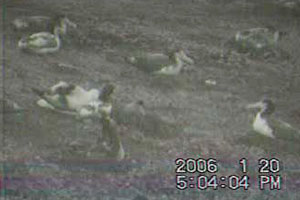
Chicks of the pair that bred for the first time in 2005-2006 (slightly to the left of the center of the image)
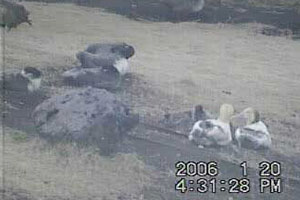
A pair that have been breeding since 1995 and the chick born in 2006 (right half of the image)
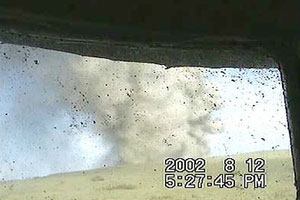
Volcanic eruption of Mt. Iou in August 2002
Thanks to this video image transmission system the ecology of the Short-tailed Albatross that used to be an unsolved mystery is beginning to unveil. It was documented by a meteorological observatory staff that the incubation period was 64 to 65 days. This was confirmed by the system. It has also become apparent that eggs are incubated by both male and female, each incubating for 10 to 20 days and maximum 25 days in succession. Young albatrosses visiting the decoy installation area are identified everyday. This is creating a big momentum for the Operation Decoy.
Marine pollution threatens short-tailed albatrosses
Albatrosses swallow plastic litters
Albatrosses mainly eat fish, squids or zooplanktons near the sea surface, and feed their chicks with the same food. However, it was found the food fed to chicks of Black-footed Albatross, which breed together with Short-tailed Albatrosses in Torishima, contains many plastic litters that float on the sea.
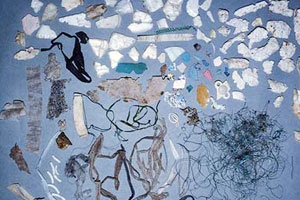
Litters found in the stomach of 20 chicks of Black-footed Albatross
These were taken out from the stomach contents regurgitated by chicks of the Black-footed Albatross. Chicks of Black-footed Albatross when captured for investigation regurgitate their stomach contents as a menacing behavior. They are captured to install leg band to study their migration routes and life-span (regurgitating their stomach contents once does not affect their growth). This picture shows artificial materials obtained from the stomach content of 20 individuals. There were styrofoams, rubber-like plastic, packaging tapes, plastic sheets, fishlines, fabric, sponge, plastics like rubber bands found. The adult albatrosses feed their chicks by regurgitating what they ate, so this means that adult swallowed litters together with food and fed their chicks. It is likely that chicks of Short-tailed Albatross are also swallowing plastics.
Investigating litters floating on the sea
In order to collect basic information on the types of litters floating on the sea where Short-tailed Albatrosses of Torishima breed, the Yamashina Institute for Ornithology is conducting investigation of floating litters in the sea around Torishima. Plastics have made our lives very convenient. However, it is a serious problem if this is impacting birds that live on far away island. It is perhaps necessary to review our lifestyle and stop putting the convenience of the humans as the only priority.
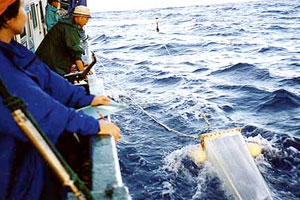
Ocean Survey

